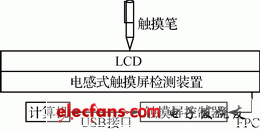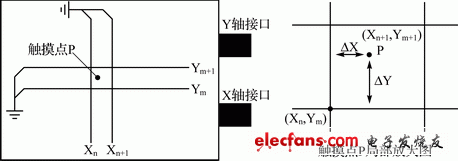The touch screen is currently the most user-friendly computer user interface [1], and is increasingly used in the consumer electronics industry [2]. The touch screen is mainly composed of two parts: a touch detection device and a touch screen controller [3]. At present, the touch detection devices of mainstream touch screen products adopt a front-end method, which causes damage to the mechanical structure of the detection device during the touch process, resulting in a decrease in touch precision of the touch screen and shortened life; in addition, commonly used capacitive and resistive touch screens The cost is relatively high. In this paper, a rear-mounted inductive touch screen is designed to avoid damage to the touch detection device during the touch process, prolong the life of the touch screen product, and the cost is relatively low. 1 How inductive touch screen works 1.1 Touch screen overall structure The overall structure of the inductive touch screen is shown in Figure 1. (In particular, the inductive touch screen uses a dedicated touch pen to achieve the touch input effect. The touch pen can emit signals in the frequency range of 120 to 180 kHz. Introduce the principle of the touch pen). Above is the LCD display, below is the touch screen detection device. The touch detection device is connected to the touch screen controller through an FPC (Flexible Printed Circuit Board). As can be seen from the touch screen structure diagram, when inputting with the touch screen, the touch pen does not directly contact the touch detection device, thus avoiding mechanical damage to the touch detection device and improving the life of the entire touch control system. Figure 1 Inductive touch screen overall structure 1.2 Touch detection device structure The touch detection device is composed of a 0.8 mm thick Printed Circuit Board with two horizontal (Y-axis) vertical (X-axis) vertical intersecting wires embedded in the PCB. They are all insulated; one end of the wire is grounded and the other end is connected to the input of the analog electronic switch CD4051 in the touch screen controller via the FPC. The number of coils in the X and Y axis directions is determined according to the size of the display. The structure of the touch detection device is as shown in FIG. 2. The touch detection device is composed of 35 coils in the X-axis direction and 30 coils in the Y-axis, and is suitable for use in a 14-inch display screen. Figure 2 touch detection device structure 1.3 How to determine the coordinates of the touch screen When the user approaches the touch pen to the detecting device, the detecting device senses the signal, and the touch signal is detected by means of time-sharing scanning. The right side of Figure 2 is a partial enlarged view of the touch point P. If the P point is touched, an electromagnetic signal is sensed on the Xn, Xn+1 and Ym, Ym+1 coils, so that the signal of the detection port changes from zero to non. zero. First, scan the X-axis direction, scan the signal on Xn through the analog electronic switch, output it to the OUT terminal from the common output pin of CD4051, and then transmit the signal to the MCU through amplification and voltage rectification circuit, and complete the A/ by the MCU. D conversion, to obtain a voltage value Vn; then scan the signal on Xn+1, also after amplification, filtering, rectification, and then send the signal to the MCU for A/D conversion to obtain a voltage value Vn+1. After the scanning in the X-axis direction is completed, the Y-axis is scanned again. Similarly, two voltage values ​​Vm and Vm+1 can be detected on Ym and Ym+1, and the detected four voltage values ​​Vn, Vn+1, Vm are used. Vm+1 can calculate the touch coordinates, and the calculation formula is as follows: Where Xn, Ym, Xn+1, Ym+1 are known coordinates, ΔVx, ΔVy are known constants, ΔVx is the difference between Vn and Vn+1 when the touch pen is on the Xn axis, and ΔVy is the touch pen The difference between Vm and Vm+1 on the Ym axis. The X and Y values ​​obtained from the touch screen controller are only the coordinates of the current touch screen, and it has no practical value. This value is not only related to the resolution of the touch screen, but also related to the fit of the touch screen and the LCD [4]. The resolution and coordinates of the LCD and touch screen are different. Therefore, if you want to get the position of the touch screen that reflects the LCD coordinates, you need to convert it in the program. The conversion formula is as follows: Among them, LCDWidth and LCDHeight are the width and height of the LCD screen, and XLCD_min, XLCD_max and YLCD_min, YLCD_max are the maximum/minimum values ​​of the horizontal and vertical coordinates of the touch screen, respectively. 2 touch screen control system hardware design The overall structure of the touch screen control circuit is shown in Figure 3. When the LCD screen is touched with a touch pen, a signal is sensed on the X and Y axes corresponding to the touch detection device. This signal passes through the analog electronic switch, and then is amplified and filtered by two stages, and the obtained signal is processed in two ways. One way is voltage rectification, the other is frequency detection circuit; the obtained data is calculated by MCU HT46RB70, the position of the touch screen and the way of touch are judged, and then the MCU sends the touch signal to the computer, and finally realizes touch input. The timing of the entire touch screen control circuit is controlled by the single-chip microcomputer. The circuits of other modules are described in detail later. Figure 3 The overall structure of the touch screen control circuit High brighteness 5050 Smd Led,all-in-one pu glue technology,professional waterpoof led strips.The pu glus is anti-uv and the color can never change in 5 years.High-flexibility, easy to install .Different colors are available,the white light color includes the range of 2700K to 6000K,also RGB colors.5 metes a roll,it can be cut by the cuttling line.Some application place need the RGB and white color,we can make RGBW strips .These led strip also has passed IP68 test,so it can be used in underwater applications. All the products have passed CE,ROHS,FCC,certification, Smd5050 Led Strip Light,5050 Smd Led,5050 Led Strip,Waterproof Strip Lights Guangdong Kamtat Lighting Technology Joint Stock Co., Ltd. , http://www.ip68ledstrip.com




January 22, 2020